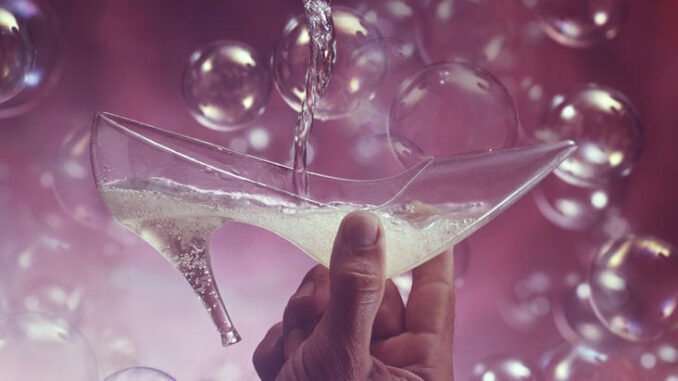
In a celebratory setting, a man’s hands pour champagne into a crystal slipper while bubbles float in the background, circa 1970. (Photo by Tom Kelley / Getty Images)
Whether it’s a wedding, graduation or New Year’s Eve, the party drink for those who love to drink is, of course, the one and only champagne. Omnipresent in its party popularity, Champagne holds a special place in the hearts of many who see it as the be-all and end-all of a party. But what if I told you that your favorite sparkling wine was made by mistake and, in fact, this very special wine was originally seen as a huge setback to those who created it?
More importantly, why did this beloved beverage first appear in Champagne, France of all places? Well, that’s because Champagne is further north than other famous wine producing regions of Bordeaux and Burgundy and therefore faces milder temperatures and early frosts. Therefore, the grapes are more acidic and the fermentation process takes longer compared to more traditional wines. However, the resulting carbonation led to the bottles breaking and the cork being thrown dramatically, if not dangerously.
Did you know: every year, more than two dozen people are killed by champagne corks? This officially makes opening a bottle of bubbly more dangerous than skydiving! Remember never to point the cork at yourself or others when opening the bottle, or you risk a Cava catastrophe.

As you can imagine, winemakers weren’t as thrilled with this “devil’s wine” as they initially called it, and saw the iconic bubbles as a major flaw. Winemakers strove to correct this, and they might have done so had it not been for their longtime enemy, England, which had a fondness for sparkling wine. Because it was considered a novelty in the courts of France, the Marquis of St. Evremond brought the drink to the English nobility in the 1600s and it soon became the talk of London. Demand for champagne exploded in London and winemakers rushed to supply it in the 1660s.
Meanwhile, in France, a Catholic monk named Dom Perignon divided his time between his religion and the problem of exploding wine bottles. He set out to better understand the fermentation process and decided to methodically prune the vines using exclusively pinot noir grapes, which he found caused fewer explosions. The perfection of the Perignon fermentation process, along with English inventions such as the cork stopper, made devil’s wine much safer to store and therefore easier to transport. We can also thank the one and only Louis Pasteur (most famous for making milk safe to drink), for making huge strides in the world of fermentation by discovering the link with yeast build-up in liquids.
In the early 1800s, another innovation came with Madame Clicquot’s charade technique, in which bottles were placed upside down on a slope and regularly turned over so that sediment collected in the neck. When they were sure that all the yeast had settled on the cork, it was removed, and the resulting champagne was clearer and tastier than ever. You can still buy Clicquot and Dom Perignon Champagne to this day, but it will cost you a pretty penny, as even the “cheaper” bottles of Dom Perignon sell for well over a hundred dollars.

Finally, winemakers have stopped looking at the secondary fermentation process as something to hate and have now embraced the effervescent beverage with open arms and heavy pockets. Throughout the 1700s, Champagne’s popularity grew thanks to the Duke of Orleans, who used it to fuel his days of rage. Finally, in the 19th century, champagne would be loved by people outside the noble class, as new technological advances made it more accessible to the general public.
While you may have heard the saying, “if it ain’t Champagne, it ain’t Champagne”, the fact is that most sparkling wines in the modern day are made to similar standards. The real question of quality, as always, is in the vine, the grapes and the climate. That said, the saying still holds, as the people of France have long protected the name Champagne from those looking to cash in on the prestigious drink. This was apparently so important to the people of France that recognition was included in the 1919 Treaty of Versailles, you know, that thing that ended WWI and, according to some historians, even set the stage for WWII. because of his hardline economic sanctions against Germany? Yes, it was very important for their culture and economy.

Technically speaking, the saying “only from Champagne” is correct, as in 1936 a wine called “Champagne” was legally defined as a sparkling wine that came exclusively from the Champagne region of France. All other wines with sparkling sugar are considered “sparkling wines”, regardless of their quality. However, one country’s law is another country’s snub, and so places like California still flaunt their prestige sparkling wine as “California Champagne” regardless of this technicality.
All things Champagne really took off from the 19th century onwards, with the drink not only taking over as the drink of choice, but ascending to a full-fledged hit icon. Since the 1800s, the United States has had a habit of throwing bottles full of champagne at its debuting ships to wish them good luck. If you’ve paid any attention to sports, you might have also noticed the Brut being showered on your favorite athletes after an important victory. Since the mid-20th century, thanks in large part to the Milwaukee Braves winning the World Series in 1957, coaches have poured champagne on their winning teams to celebrate both joy and exceptionalism.
As the end of 2020 approaches, people across the world will choose to ring in the New Year with a glass of bubbly, all thanks to particularly cold soil a few hundred years ago in a northern province of